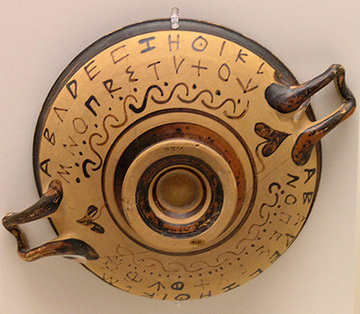More Language Topics
More Topic Categories
Ancient Greek Alphabet
 The Ancient Greek alphabet appeared during the late 9th or early 8th century BC. It derived from the already existing Phoenician alphabet, out of which many other European scripts evolved. In its original form, the Greek alphabet did not have a distinction between upper – case and lower – case letters, just like the Latin alphabet; both of these scripts developed this distinction during the modern era. Some of the sounds of the letters of the Ancient Greek and the Modern Greek alphabet have changed due to phonological changes in the language. Moreover, words in Ancient Greek (and the polytonic system) can be combined with several diacritics, such as different types of accents and the iota subscript, thus effectively changing the way a word is pronounced. The polytonic system has been rendered obsolete since the 1980s and the monotonic system is now used in Modern Greek.
The Ancient Greek alphabet appeared during the late 9th or early 8th century BC. It derived from the already existing Phoenician alphabet, out of which many other European scripts evolved. In its original form, the Greek alphabet did not have a distinction between upper – case and lower – case letters, just like the Latin alphabet; both of these scripts developed this distinction during the modern era. Some of the sounds of the letters of the Ancient Greek and the Modern Greek alphabet have changed due to phonological changes in the language. Moreover, words in Ancient Greek (and the polytonic system) can be combined with several diacritics, such as different types of accents and the iota subscript, thus effectively changing the way a word is pronounced. The polytonic system has been rendered obsolete since the 1980s and the monotonic system is now used in Modern Greek.It should also be noted that Ancient Greek is not related to a previous form of writing in Greece, called Linear B. This script was in use during the Mycenaean Period, when the Mycenaean Civilization flourished; after the decline of this civilization due to attacks by the so – called sea people as well as the Dorians, Greece entered a period known as the Dark Ages, during which literacy and culture not only halted but was lost completely. When Greece reemerged from the Dark Ages, the Phoenician alphabet was adopted (as the Phoenicians were the tradesmen at that time) and was modified, thus creating the Greek alphabet. The Greek alphabet initially adopted all 22 letters of the Phoenician alphabet, some of them in different ways, while new letters were also introduced. Greek was originally written from right to left, just like Phoenician, but scribes were free to choose the direction of their liking. In fact, a writing style appeared, called boustrophedon, which is a bi – directional text, as every other line of writing is reversed with reversed letters.
As already mentioned, one of the differences between the Ancient Greek and Modern Greek alphabet is the usage of three accent marks in the former. These were the acute accent (ά), the grave accent (ὰ) and the circumflex accent (ᾶ). These marked differences in the way the word should be pronounced in terms of its pitch accent. Moreover, the iota subscript (ᾴ) was also used, which also added a different phonetic way in pronouncing a word. Finally, there were also two “breathing – marks”, the smooth breathing (ἀ) and the rough breathing (ἁ). All of these symbols were abandoned in 1982, when the so – called monotonic system was adopted; the only surviving mark in Modern Greek is the acute accent (ά).
See Also:
 Athens Photos
Athens Photos
 Santorini Photos
Santorini Photos
 Crete Photos
Crete Photos
 Meteora Photos
Meteora Photos
 Corfu Photos
Corfu Photos

